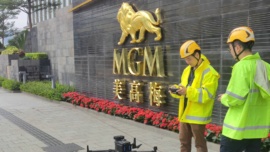In late April the Macau Government announced the awarding of a contract for operation and maintenance assistance services (O & M contract) for the Macau Light Rail Transit (LRT) Taipa Line to MTR.
The contract – worth an eye-watering MOP5.88 billion – is not only one of the biggest in the history of the LRT project but the latest of several inked between these two parties.
Macau Business contacted the Transportation and Infrastructures Bureau (GIT) to learn exactly how many contracts have been signed with MTR, and what amounts are involved, but were directed to search their website, where only one of these contracts appears; that is, the latest one. A different page (‘Progress for the Macau LRT’) refers to only one link to the Hong Kong company, as well; in this case the first contract . . .
Dogged insistence on our part revealed no results.
 Our efforts with the MTR have not been any more successful. ‘2011–now: MTR was awarded multiple contracts for providing project management from training, design submission review, projects progress review to technical support services regarding the Macau LRT Project by the Transportation Infrastructure Office,’ trumpets the information delivered to our magazine.
Our efforts with the MTR have not been any more successful. ‘2011–now: MTR was awarded multiple contracts for providing project management from training, design submission review, projects progress review to technical support services regarding the Macau LRT Project by the Transportation Infrastructure Office,’ trumpets the information delivered to our magazine.
Macau Business has undertaken the most thorough research possible from the MSAR press since 2002 and has come to the conclusion that at least seven contracts have been signed between the parties (there may, of course, be more).
An analysis of the dates of these contracts shows that the MTR has been involved in the Macau LRT project from the outset. In 2002, the first Chief Executive of the Macau SAR, Edmund Ho, entrusted the Mass Transit Railway Corporation Limited to undertake a preliminary study of the Macau urban railway transport system (see text on this page). The Hong Kong company confirms: ‘2002–2005: MTR undertook feasibility studies of Macau’s Light Rapid Transit System for the Macau SAR Government.’
 Although the MTR refers to 2011, by our reckoning the following contract appeared only ten years later, 2012: MTR was hired for the ‘Independent Review of the Light Rail System and Train Design.’
Although the MTR refers to 2011, by our reckoning the following contract appeared only ten years later, 2012: MTR was hired for the ‘Independent Review of the Light Rail System and Train Design.’
This does not mean that between 2002 and 2012 the Hong Kong giant was absent from the project. On the contrary: it turns out that either it did not compete (though invited) or lost.
In 2008, GIT invited five companies to participate in the ‘Feasibility Study Consultation for Stage 2 of the Macau Light Rail System.’ The MTR was on this shortlist but did not formalise entry into the process. The explanation may be related, given they had lost a tender for ‘Provision of Project Management and Technical Assistance Services for the Implementation of the 1st Phase of the Light Rail System of Macau’ to a French-Portuguese consortium led by EGIS.
Over the next four years there is no record of the presence of the MTR until in 2012 it embarked upon a cycle of six contracts, which means that in 2014 alone there was no news.
If in 2012 MTR was hired for the ‘Independent Review of the Light Rail System and Train Design,’ in the following year it was in charge of conducting the ‘Consolidated Study of the Macau Light Rail System Ticket Sales Strategy.’
In 2015, GIT and MTR also signed a contract for the first stage of technical support for the contingency plans for the city’s LRT depot and in the next year the MTR Corporation Limited was awarded a contract for the provision of management and technical assistance for the city’s LRT projects.
Last year, the government of Macau approved a contract for additional management and technical assistance for the LRT project and finally this year the mega-contract for the operation and maintenance of the Taipa Line.
The contract is so significant that MTR decided to activate its local subsidiary, MTR Railroad Operations (Macau) Sociedade Unipessoal Lda. The service scope will include the Macau LRT Taipa Line’s testing and commissioning activities, operation of train services, and maintenance of trains, signalling system and infrastructure for a period of 80 months. And also for the first time, 16 years after starting the connection, they placed the Macau LRT project on the list of international projects featured on their website.
“The MTR Corporation is delighted to have the opportunity to participate in the operations of Macau’s first railway system and serve the travelling public in Macau,” the company told Macau Business. “Building on the Corporation’s proven operational expertise in Hong Kong and international markets, we are confident in delivering quality services and contributing to Macau’s railway development.”
MOP6.5 billion
| Year | Contract | Value |
| 2002 | Preliminary study of Macau urban railway transport system | MOP7.5 million |
| 2012 | Independent Review of Light Rail System and Train Design | MOP7.5 million |
| 2013 | Consolidated Study of Macau Light Rail System Ticket Sales Strategy | MOP3.7 million |
| 2015 | First stage of technical support for contingency plans for city’s LRT depot | MOP54.1 million |
| 2016 | Provision of management and technical assistance for city’s LRT projects | MOP474.3 million |
| 2017 | Additional management and technical assistance for LRT project | MOP68.1 million |
| 2018 | Operation and maintenance assistance services for Taipa Line | MOP5.88 billion |
(N.b: In some cases figures collected from press; designation of contracts may not be exactly the most rigorous)
MTR proposed metro underground
The first study on a means of urban rail transportation in Macau, commissioned in 2002 from the MTR and delivered in 2005, advocated an underground solution.
The text – titled ‘Summary of the Final Report of the Feasibility Study of the Metropolis of Macau’ – provided for the introduction of an underground system for the Macau Peninsula (with passageways through Avenida de Amizade and Avenida da Praia Grande) plus the construction of a viaduct for the island of Taipa.
‘Later, a consulting firm conducted a feasibility study of the proposals contained in the report drawn up by the Hong Kong MTR, indicating that the underground light rail system would increase construction and operating costs, cause greater technical difficulties . . . without providing detailed information on scientific data and supporting documents,’ according to the Commission Against Corruption Activity Report (2012).
























